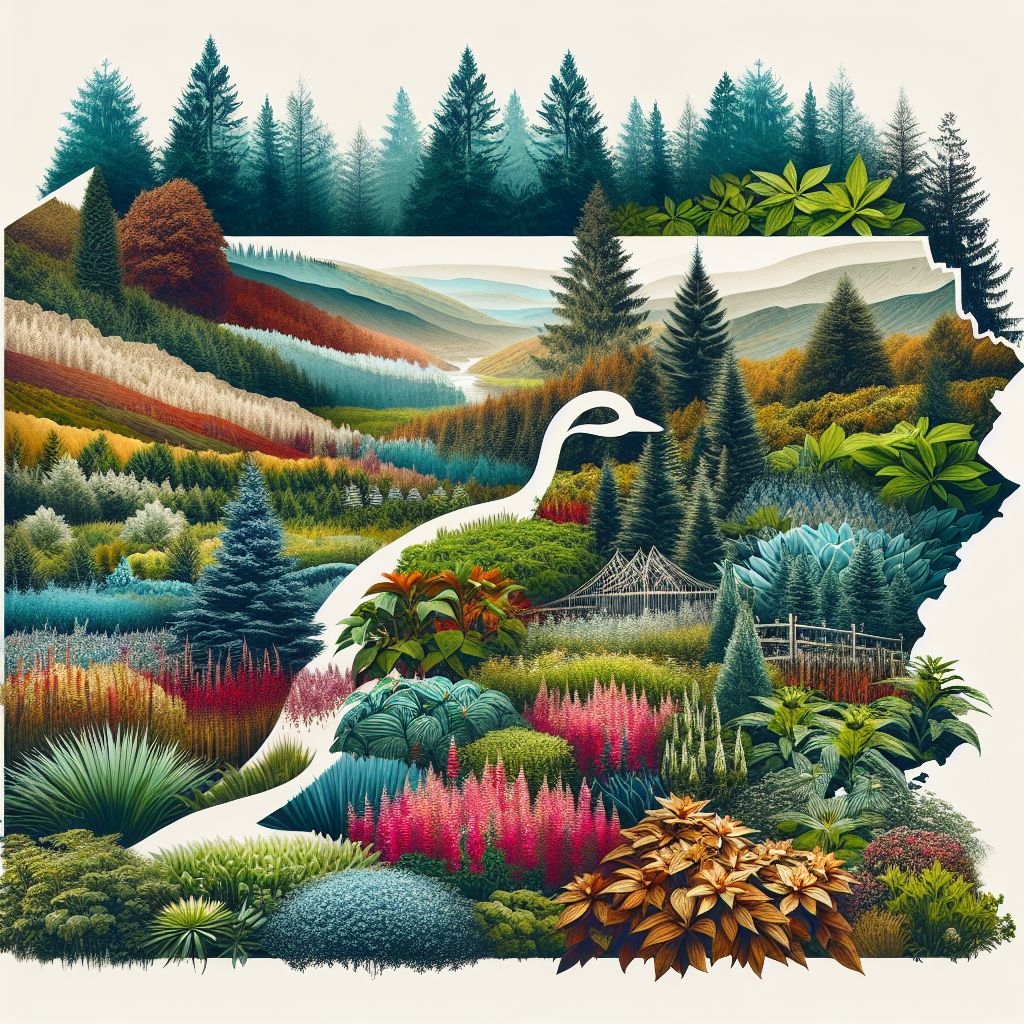Key Takeaways
- Discover the best native trees for a Pennsylvania xeriscape
- Understand the benefits of
in varying climates - Learn how to budget effectively for your xeriscaping project
- Get practical tips for maintaining a healthy, eco-friendly garden
- Explore design inspirations for a water-wise landscape
Jumpstarting Your Xeriscape Adventure
Imagine transforming your yard into a thriving oasis that not only dazzles with beauty but also conserves water and supports local wildlife. That’s the magic of xeriscaping, a landscaping philosophy that pairs eco-consciousness with stunning visuals. Let’s dive into how you can make this a reality in your Pennsylvania home.
The Whys and Hows of Xeriscaping
Xeriscaping isn’t just about surviving dry spells; it’s about thriving with smart plant choices. Why xeriscape? Because it’s a savvy way to reduce your water usage, cut down on maintenance time, and create a habitat for local fauna. How do you do it? Start with assessing your yard’s current condition—note the sunny spots, the soil type, and the existing vegetation.
First Steps to a Lush, Water-Wise Garden
First, you’ll want to sketch a rough layout of your space. Mark areas for trees, shrubs, and perennials. Consider pathways and borders. Most importantly, think about water flow—where does it collect, and how can you utilize this for your plants? This initial plan will be your roadmap to a garden that’s both beautiful and sustainable.
Best Native Trees for Your Pennsylvania Xeriscape
Choosing the right trees is critical for a successful xeriscape. You’ll want species that are naturally adapted to Pennsylvania’s climate and soil. These trees will require less water and be more resistant to local pests, reducing the need for chemical treatments.
Red Maple: A Splash of Fall Color
The Red Maple is a stunning choice for any yard. It’s not just the fiery red fall foliage that makes it a standout; this tree is also incredibly adaptable. It can thrive in a variety of soil types and moisture levels, which means less fussing for you and more time enjoying its year-round beauty.
Eastern White Pine: Majestic Year-Round Greenery
If you’re after evergreen elegance, the Eastern White Pine is your go-to. This tree doesn’t just look good; it provides essential cover for wildlife throughout the year. It’s tall and stately, perfect for creating natural privacy screens while requiring minimal upkeep.
Eastern Red Cedar: Resilient and Wildlife-Friendly
The Eastern Red Cedar is another evergreen that brings robustness and resilience to your garden. It stands up well to heat and drought, and its dense foliage offers shelter and nesting sites for birds. Plus, its berries are a food source for wildlife, making it a valuable addition to any eco-friendly landscape.
Cost-Effective Xeriscaping: Budgeting for Beauty
Now, let’s talk numbers. Xeriscaping can be surprisingly cost-effective, especially when you choose native plants. Why? Because they’re already suited to your local environment, meaning less water, less fertilizer, and fewer replacements. To get a clearer picture, here’s a quick budget breakdown:
Red Maple trees can range from $50 to $150, depending on the size and maturity of the plant. Eastern White Pines and Eastern Red Cedars fall within a similar price bracket. Remember, these are long-term investments that pay off in reduced water bills and maintenance costs.
Keep in mind, the initial setup might involve some additional expenses for soil amendments, mulch, and perhaps some hardscaping materials. However, by planning carefully and choosing the right materials, you can keep costs down and ensure a garden that’s as economical as it is ecological.

Cost-Effective Xeriscaping: Budgeting for Beauty
When embarking on your xeriscaping journey, it’s crucial to have a clear understanding of the costs involved. Planning is your best friend here, as it will prevent unexpected expenses and ensure that your project stays within budget. A well-thought-out xeriscape can save you money in the long run by reducing the need for watering, fertilizers, and maintenance.
Estimating Your Xeriscaping Budget
To start, list out the elements you’ll need for your xeriscape: plants, mulch, soil amendments, and any hardscaping features. Each item comes with its price tag, but remember, native plants often cost less to maintain. For instance:
- Native trees like the Red Maple typically range from $50 to $150, depending on size.
- Perennials may cost between $4 and $12 per plant.
- Mulch is usually priced by the cubic yard, with costs around $30 to $60.
- Soil amendments and compost could add another $20 to $50 to your budget.
These are ballpark figures to give you a starting point. Prices will vary based on your specific needs and local availability. Most importantly, consider the long-term savings on water and care that these native plants will afford you.
Remember, xeriscaping is an investment in your property’s future. By allocating your budget wisely, you’re not only beautifying your space but also promoting sustainability and biodiversity.
Tips for Saving Money on Native Plants and Materials
Everyone loves a good deal, and with xeriscaping, there are plenty of ways to keep your wallet happy. Here’s how:
- Buy young plants. They’re cheaper and, with time, will grow into your space perfectly.
- Look for local plant swaps or sales at botanical gardens and conservation groups.
- Choose multipurpose hardscape materials that serve both aesthetic and functional roles.
- Use organic mulch like leaves or pine needles that you can gather for free.
- Do the work in phases to spread out the costs over time.
These strategies can significantly reduce your initial outlay while still allowing you to create a vibrant, water-wise garden.
Effortless Upkeep: Maintaining Your Native Landscape
Maintenance is where xeriscaping really shines. Native plants are already accustomed to local conditions, which means they’ll thrive with minimal intervention. This translates to less work for you and more time to enjoy your garden.
However, some maintenance is necessary to keep your xeriscape healthy and attractive. Regular checks will help you spot any issues early on, allowing for quick solutions that prevent bigger problems down the line.
Watering Wisdom for Xeriscaped Gardens
Water is a precious resource, and xeriscaping is all about using it wisely. Even drought-tolerant plants need water to establish their roots. Once they’re settled, though, your watering duties will diminish. Here’s a tip: water deeply but infrequently to encourage strong root growth, which helps plants become more resilient and self-sufficient.
Combating Pests Naturally
Pests can be a challenge, but in a well-planned xeriscape, nature often takes care of the problem. Birds and beneficial insects are your allies here. By choosing a variety of plants, you create a balanced ecosystem that keeps pests in check without the need for harsh chemicals.
Seasonal Pruning for Plant Health
Pruning isn’t just about keeping plants tidy; it’s also about promoting healthy growth. Remove dead or diseased branches to prevent the spread of decay and to open up the plant for better air circulation. Just remember to prune at the right time for each species to avoid cutting off next year’s blooms.
Cultivating a Desert Oasis: Dry-Climate Inspirations
Even though Pennsylvania isn’t a desert, you can still draw inspiration from arid-landscape designs. Xeriscaping embraces the concept of creating lush, attractive gardens with plants that thrive in low-water conditions, and there’s a surprising variety of these that can flourish in Pennsylvania’s climate.
Adapting Southwestern Xeriscaping Styles for Pennsylvania
Adapting the vibrant colors and dynamic textures of Southwestern gardens to Pennsylvania’s environment can add a unique flair to your landscape. Here’s what you can incorporate:
- Gravel and stone for low-maintenance ground cover that reflects heat.
- Succulents and cacti in containers for a touch of the exotic (bring them in during winter).
- Native grasses that provide movement and interest with virtually no upkeep.
These elements, when blended with local plants, can create a stunning visual impact while staying true to the principles of xeriscaping.
And don’t forget, your xeriscaped garden isn’t just for looks. It’s a functional space that can provide a habitat for local wildlife, reduce your carbon footprint, and offer you a peaceful retreat from the hustle and bustle of daily life.
Selecting Plants for a Desert Ambience
Creating a desert ambience in Pennsylvania is all about plant selection. Opt for species that mimic the look and feel of desert plants but can handle the local climate. Think sedums, yuccas, and agaves. These plants can give you the desert vibe you’re after while still being practical for your area.
Pennsylvania Xeriscaping Guide: Easy-Care Flower & Plant Landscaping with Native Trees
| Plant | Description | Estimated Cost |
|---|---|---|
| Red Maple | Deciduous tree with vibrant fall foliage, reaching 40-60 ft tall. | $50-$150 |
| Eastern White Pine | Evergreen conifer with soft, feathery needles, growing 50-80 ft tall. | $75-$200 |
| Coneflower | Native perennial with large, daisy-like flowers that attract pollinators, growing 2-4 ft tall. | $10-$20 per plant |
| Sumac | Drought-tolerant shrub with distinctive red fall foliage, reaching 6-15 ft tall. | $20-$50 |
| Beebalm | Fragrant perennial with showy red, pink, or purple flowers that attract hummingbirds, growing 2-4 ft tall. | $10-$20 per plant |
References:
https://www.wildflower.org/plants/
This table is just the beginning. There are countless options to explore, each with its own unique beauty and benefits. For more inspiration on sustainable landscaping with native species, consider exploring this guide on xeriscaping with native shrubs and flowering plants.
As you weave these design elements into your Pennsylvania landscape, remember that xeriscaping is more than just a gardening trend; it’s a commitment to a sustainable lifestyle. It’s about creating a space that respects the local environment, conserves resources, and offers a serene escape for you and the local wildlife.
So, whether you’re an experienced gardener or just starting out, embrace the principles of xeriscaping. With a little planning and creativity, you can turn your yard into a stunning, water-wise garden that flourishes year after year.
Design Features That Save Water and Boost Appeal
Designing a xeriscape doesn’t stop with plant selection. Incorporating water-saving features is key to achieving both functionality and beauty. Consider adding rain barrels to collect water for irrigation, or installing a drip irrigation system for efficient watering. Use permeable paving materials for paths and patios to allow rainwater to recharge the groundwater instead of running off. These features not only save water but also add to the aesthetic appeal of your garden.

Frequently Asked Questions (FAQ)
What Is Xeriscaping Exactly?
Xeriscaping is a landscaping approach that reduces or eliminates the need for supplemental water from irrigation. It involves choosing plants that are drought-resistant, particularly native species, and designing landscapes to take advantage of rainfall and natural climate conditions. Xeriscaping is a smart choice for gardeners looking to create a beautiful, low-maintenance garden that’s kind to the environment.
Can Xeriscaping Really Withstand Pennsylvania Winters?
Absolutely! Xeriscaping isn’t just for arid climates. It’s about choosing plants that are right for your local environment, including those that can handle Pennsylvania’s cold winters. Native plants have evolved to thrive in local conditions, including the seasonal temperature fluctuations. With proper plant selection, your xeriscape will be as resilient in winter as it is during the summer months.
Remember, xeriscaping is about working with nature, not against it. By aligning your garden with the rhythms of the Pennsylvania climate, you create a landscape that lives in harmony with its surroundings.
How Often Should I Water My Xeriscaped Garden?
Once established, your xeriscaped garden will need very little water. Initially, you’ll want to water your plants to help them establish strong root systems. After that, they will require watering only during prolonged dry spells. The beauty of xeriscaping is that it’s designed to thrive with minimal water, relying mostly on natural precipitation.
Are Native Trees Resistant to Local Pests?
Native trees are generally more resistant to local pests than non-native species because they have co-evolved with these pests over time. However, no plant is entirely pest-free. The key is to create a diverse garden ecosystem that encourages natural pest control through beneficial predators and insects.
Where Can I Purchase Native Plants for Xeriscaping?
You can find native plants for your xeriscaping project at local nurseries, garden centers, and plant sales hosted by botanical gardens or conservation groups. These sources often offer a wide selection of native species that are well-suited to Pennsylvania’s climate. Additionally, online plant databases and gardening forums can be excellent resources for finding specific native plants and learning more about their care.
Creating a xeriscape in Pennsylvania is a rewarding endeavor that brings beauty, ecological balance, and water conservation to your home landscape. By selecting the right native trees and plants, budgeting wisely, and incorporating sustainable design features, you’ll be well on your way to establishing a garden that’s both stunning and environmentally responsible. Happy gardening!
Now go ahead, let your green thumb guide you, and transform your outdoor space into an eco-friendly paradise that’s the envy of the neighborhood!





Leave a Reply